11 Different Tomato Varieties And The Best Way To Cook With Each

Tomatoes are so much more than the old "tomayto" vs. "tomahto" debate — there are actually over 10,000 different varieties! From cherry-sized micro tomatoes to beefsteak varieties that require two hands to hold, the tomato world is wide-ranging and colorful.
Those 10,000 varieties are separated into two major categories: heirloom and hybrid tomatoes. Heirloom varieties, cherished for their rich flavors, are open-pollinated species that have been passed down through generations. Hybrid tomatoes are the labradoodles of tomatoes: Two different types of tomatoes are crossbred to bring out the best traits of both.
Tomatoes are also categorized by physical characteristics, such as shape and size. There are globe tomatoes that fill the produce section of your local grocery store, small cherry and grape tomatoes that are ready to dive into a salad, and firm plum and paste varieties that are the go-to for cooking sauces and pastes. With all these choices, picking the right tomato for your dish might be the hardest part of cooking. If a recipe doesn't specify what type of tomato to use, the results could vary dramatically given the differences in tomato textures and flavors. So let's explore the world of tomatoes and consider some of the best ways to use each variety.
Read more: Mistakes You're Making With Your Corn On The Cob
Globe Varieties: Jack-Of-All-Trades In The Kitchen

When most people think of a tomato, they're probably thinking of a globe tomato. They're widely available and often labeled at the grocery store as "red tomatoes." These are your everyday, go-to tomatoes — medium to large in size, round, and typically red. Juicy, with a perfectly balanced flavor, they're the ideal candidates for almost anything you throw at them.
Want to jazz up your sandwich or crown your salad with some royal reds? Slice up a globe tomato. They're just the right size and have that firmness that holds up beautifully between two slices of bread or alongside your greens. For cooking, whether you're roasting them to bring out a caramelized sweetness or grilling them to add a smoky edge, globe tomatoes are ready to take the heat. In sauces and stews, their fleshiness adds substantial texture and rich flavor.
Among the stars of the globe tomato family, we have some celebrities (literally!). The Celebrity variety is reliable and tasty, perfect for those everyday tomato needs. Then there's the Early Girl, the eager beaver of tomatoes, popping up early in the season and sticking around to keep your dishes fresh all summer long. And the Big Boy variety lives up to its name with sizeable, bright red fruits that make the perfect plus-one for burgers and sandwiches.
Beefsteak Varieties: The Best Sandwich Slices

Meaty, juicy, and large — that's a beefsteak tomato, sometimes tipping the scales at over two pounds! Beefsteak's hefty size means a slice can easily match the size of your burger or sandwich. Given its size and vibrant flavor, a beefsteak tomato was made to take center stage in a scrumptious BLT or a veggie alternative like a Basil Lettuce Tomato. The beefsteak's heartiness and texture also work well in salads, especially those taking the spotlight as the main course. If you're ready to venture beyond slices and salads, try an easy feta-stuffed tomato recipe. The beefsteak pairs well with feta and the tomato's size makes it ideal for stuffing.
Beefsteak tomatoes tend to have a mild and sweet flavor, though there are many beefsteak varieties —well over 300! One of the most famous varieties of beefsteaks is the Brandywine, a well-respected heirloom tomato with roots tracing back to the 1880s. The Brandywine has a rich and superior tomato flavor. Unfortunately, you might have a hard time finding Brandywine tomatoes at the grocery store, but they often pop up in farmers' markets in late summer.
Beefsteak varieties come in many colors, such as the Cherokee Purple and the Black Krim. The Cherokee Purple tastes similar to Brandywine but, as its name suggests, is purple. The Black Krim's deep flavor is just as intense as its dark maroon coloring. The Cherokee Purple and Black Krim both make colorful and delicious additions to your sandwich or salad.
Cherry Varieties: Pops Of Sweetness And Color
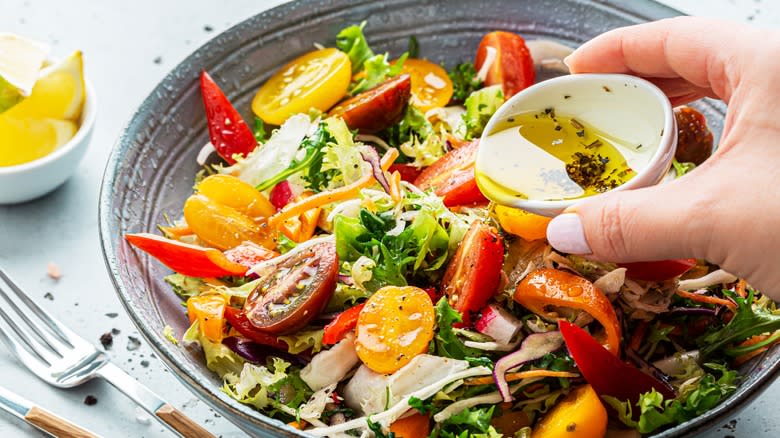
Cherry tomatoes are smaller than your average tomato, but what they lack in size, they make up for in sweetness. They're a tasty and colorful addition to any salad — toss 'em in whole or halved. With so many cherry tomato varieties, you'll have your choice of colors. From the classic reds of varieties like Sweet Million and Sweet 100, to the sunny allure of the golden-orange Sungold, and the bright yellow of the Yellow Pear variety.
These colorful and sweet pops of flavor shine in salads, but they're also great cooked. Cherry tomatoes make a simple and delicious pasta add-in. As they cook, they burst slightly, releasing their sweet, tangy juices, which mingle beautifully with both light olive oil-based sauces and richer, creamier ones.
You might also turn up the heat a bit — literally. Roasting cherry tomatoes enhances their flavor with a smoky sweetness. Elevate a simple pasta sauce, create a delicious side dish, or upgrade a pasta salad by using roasted cherry tomatoes. You can even use your air fryer to make delicious roasted cherry tomatoes in less than 15 minutes.
Grape Varieties: Great On The Grill

The small, oblong grape tomato often gets mixed up with its slightly bigger and rounder cousin, the cherry tomato. Both are versatile tomatoes with many great uses, from snacking to salads to cooking. But there are some key differences between grape and cherry tomatoes. Grape tomatoes come in a more elongated shape, much like, well, a grape! They have a firmer texture that doesn't burst as easily — you can really sink your teeth into a grape tomato without making a mess. One of the most common grape tomato varieties is the Santa, a name as cheerful as its flavor profile.
While they may be slightly less sweet than cherry tomatoes, grape tomatoes offer a robust taste that becomes even more pronounced when cooked. Thanks to their thick skin and meaty inside, grape tomatoes maintain their shape under heat — this makes them a fantastic choice for grilling. Any recipe for grilled veggie kabobs that calls for cherry tomatoes will likely also work well with grape tomatoes.
Grape tomatoes are also known for their long shelf life. Some of those characteristics that make them durable under heat also make them last longer. They're tough little tomatoes that stand up well to packing and transport, so they tend to be widely available at grocery stores and farmers' markets.
Plum Varieties: Perfect Pizza And Pasta Sauces

Oval-shaped plum tomatoes are firmer, hold fewer seeds, and are less juicy than their round relatives. So if you're looking to cook up tasty, seed-free, non-watery sauces, plum tomatoes are a good bet. They're also one of the best choices for canning — their rich and tangy flavor gets even better during the canning process.
Roma is a well-known plum variety. Also known as Italian tomatoes, Romas are the secret behind that thick, rich tomato sauce we love on our spaghetti. Romas are commonly used for cooking Italian sugo al pomodoro, aka tomato sauce. But they don't stop there — Romas are also a common choice for other Italian favorites, like classic tomato bruschetta.
Chefs treasure the San Marzano, another plum variety. These tomatoes are so special, they're legally protected! Only tomatoes grown in a particular area of Southern Italy can call themselves San Marzano. Their flavor is vibrant and they have few seeds, making them a top pick for delicious and fuss-free pasta and pizza sauces. To be authentic, a Neapolitan pizza must use San Marzano tomatoes. They're also the best tomatoes for homemade tomato soup. When the tomato flavor is front and center, like in a good tomato soup, splurging on San Marzano tomatoes can make a difference — they're more pricey since they have to be imported. But if you're whipping up something with lots of bold spices and flavors, like a hearty chili, you might go for a more budget-friendly tomato option.
Paste Varieties: The Secret To Rich Pastes And Purées
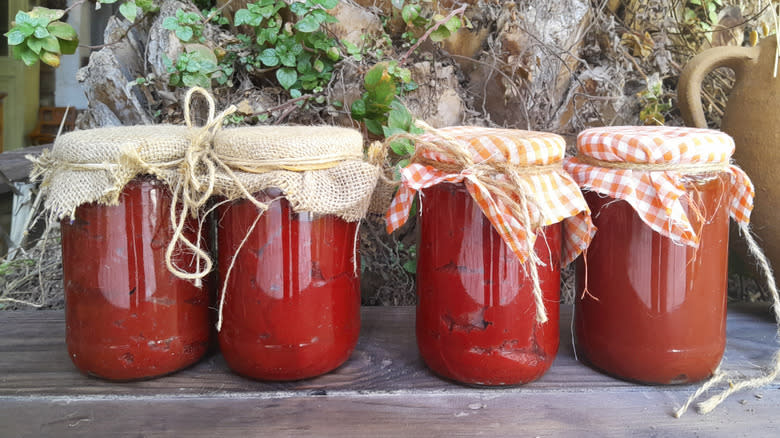
Paste tomatoes, plum tomatoes, Roma tomatoes — what's the difference? It's all a bit squishy. Some cooks don't bother differentiating among these categories, which overlap. Here's a simple way to look at it — if it's usually used to make sauces, it's possibly or probably a paste tomato.
Professional horticulturalist and writer Lee Reich sheds some light on this. Writing for the New York Times, Reich explains that a paste tomato is basically any flavorful and juicy tomato that's a champ for cooking, regardless of its shape. Under this definition, Roma and San Marzano tomatoes proudly wear both the "paste tomato" and "plum tomato" badges. Both varieties make superior sauces and perfect pastes.
But like your tomato paste, the plot thickens with other paste varieties, such as Amish Paste and Opalka tomatoes. The Amish Paste tomato variety is known to retain its rich flavor after cooking. And that's exactly what you need if you're making paste and subjecting tomatoes to hours of heat. The Opalka variety is another good option, a large and slender paste variety. It keeps things neat with a low seed count, making it ideal for smooth pastes and purées.
Cocktail Varieties: Versatile Bites For Snacking And Savoring

Perk up your palate and your plates with cocktail tomatoes. Larger than the cherry tomato, but not quite as big as the plum tomato, cocktail tomatoes strike a perfect balance. With a sweet and tangy flavor, they're ideal for snacking and salads. And they've got a name that suggests they wouldn't mind being invited to your next cocktail party, where they'd happily rub shoulders with cheese, olives, and an array of cured meats.
The Campari tomato is the most well-known cocktail tomato, a common vivid red sight in grocery stores and the world's first branded tomato. Campari are versatile tomatoes, which work well in cooking or eaten raw. Show off their vibrant red interior by slicing them up to be bright bites on your charcuterie board.
But not all cocktail tomatoes wear a little red dress. The Kumato cocktail tomato comes in an intriguing brown. Sweet and tart, Kumato tomatoes pair well with Mediterranean flavors — olives, feta cheese, and sourdough bread are happy to mingle with Kumato tomatoes. Experiment using brown Kumato in recipes like a delicious Mediterranean Pasta Salad side dish or a refreshing Greek salad for a perfect lunch that feels like a quick getaway to the Greek Isles.
Green Tomatoes: Fried Delights
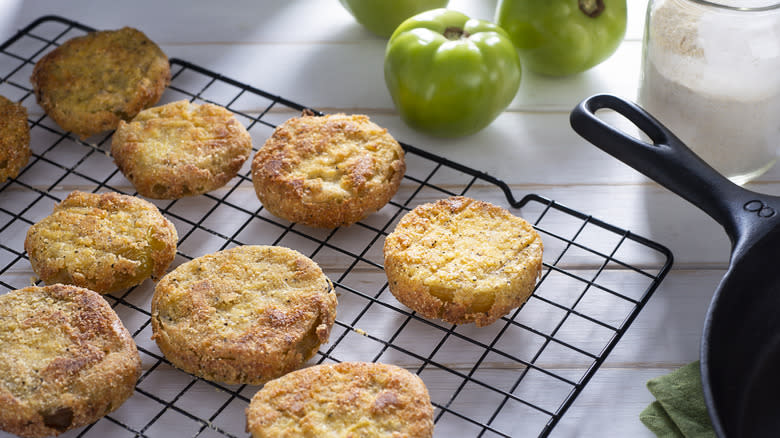
Unripe green tomatoes were made famous in the classic movie "Fried Green Tomatoes." These fried delights take a firm, tart, unripe tomato and fry it to golden perfection in a cornmeal coating. Despite their strong association with the American South, fried green tomatoes were not originally a Southern staple. Robert F. Moss, a food historian in South Carolina, did a bit of culinary sleuthing. While he couldn't find any early recipes of fried green tomatoes in Southern cookbooks or newspapers, he did find multiple fried green tomato recipes in Jewish and Midwestern cookbooks of the late 1800s and early 1900s. Nowadays, you can even enjoy green tomatoes fried in an air fryer. Delicious as an appetizer or side dish, fried green tomatoes also make a tasty sandwich or burger topping.
As delicious as fried green tomatoes might be, not all green tomatoes are destined for frying. While fried green tomatoes use unripe tomatoes that haven't reached their mature color, green tomatoes can also refer to ripened tomatoes that are green. Green Zebras, one of the most common green varieties, remain green even when fully ripe. They also sport a striking striped pattern — combine that look with a sweet and fruity flavor comparable to red tomatoes, and you can bet Green Zebras add a splash of fun when added raw to any salad. Green Zebras also work well for making green sauces and salsas.
Other Heirlooms: A Tapestry Of Tastes And Colors
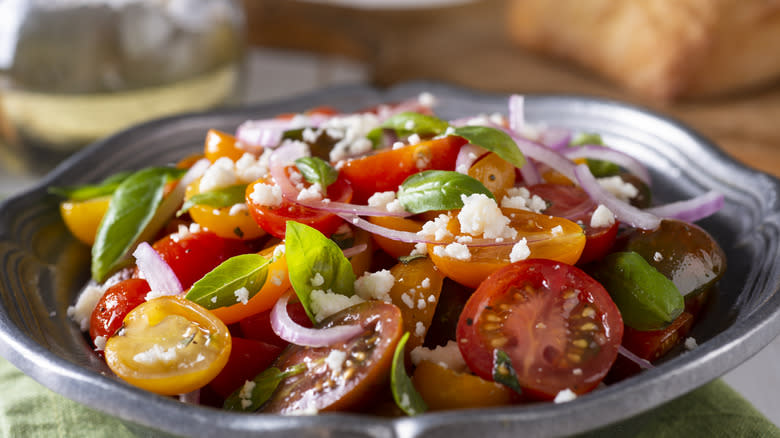
Heirloom tomatoes aren't your regular run-of-the-mill grocery store tomatoes. They're more like the vintage wine of the tomato world. An heirloom variety has been passed down through generations in seed form — some date back hundreds of years. They're the antiques of the agriculture world but way tastier than old furniture.
You'll find heirloom tomatoes in a variety of shapes, flavors, and colors. Imagine a rainbow that includes Peaches and Cream, Xanadu Green Goddess, and Cherokee Purple. But heirloom tomatoes are so much more than just good looks. Due to their genetic diversity and careful selection process, these tomatoes often offer richer and more complex flavors than their commercial counterparts. When cooking with heirlooms, keep it simple. These tomatoes are so good on their own that you don't need to do much. Toss them in a salad, layer them in a sandwich, or give them a quick roast or a gentle sauté. Or just enjoy them with a sprinkle of salt.
While availability will vary by region and season, you're more likely to find heirloom tomatoes at farmers' markets or specialty food stores rather than regular grocery stores. But be prepared for sticker shock — heirloom tomatoes are expensive because they're kind of high-maintenance — they need more care, produce less fruit, have a fleeting shelf, and taste so good that they're in high demand. But splurging might be worth it because a delicious heirloom can significantly enhance your tomato-based culinary masterpiece.
Sundried Tomatoes: Elevate Everyday Meals

After sunbathing to perfection (or drying through other methods), sundried tomatoes lose most of their water content. This process intensifies their flavor, making them both sweeter and more tart than fresh tomatoes. Keep them on hand as a versatile secret weapon to easily elevate everyday meals.
Sundried tomatoes are good cold or hot, so toss a new flavor into your salad or add some chewy sweetness to your pasta. If you're looking for inspiration, try a creamy sundried tomato pasta recipe. You'll enjoy a range of flavors in one delicious dish, with the sundried tomatoes adding an extra vibrant and tangy kick that perfectly complements the smooth, rich sauce.
Beyond salads and pasta, sundried tomatoes also go well with chicken dishes. They are a key ingredient to Marry Me Chicken, a dish so delicious it can practically coax a marriage proposal! Tender chicken breasts cooked in a creamy sauce made luxurious with the addition of sundried tomatoes — that depth of flavor might be just what you need to deepen your relationship. Yes, sundried tomatoes might have that kind of power.
Micro Tomatoes: Small Garnishes Big On Flavor
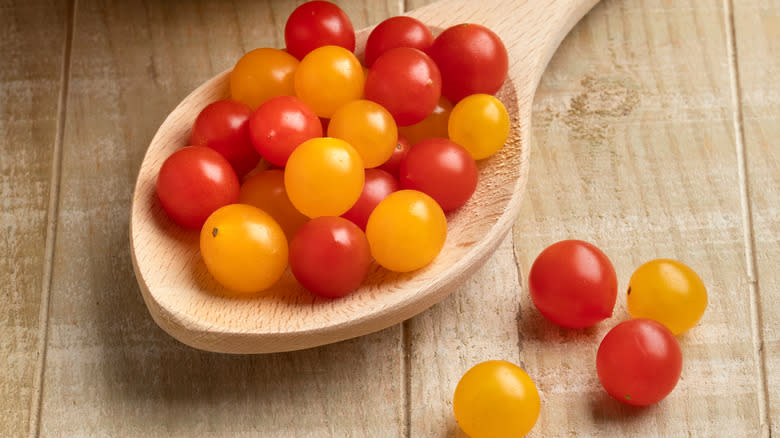
Don't let their size fool you — micro tomatoes may be tiny, but they pack a flavorful punch. These teeny bundles of tomato goodness are often less than half an inch in diameter. At the risk of mixing measurement systems, sometimes they barely reach half a centimeter! They come in many colors, but red, orange, and yellow are most common. Because of their cute, small size and bright, attractive colors, they're perfect garnishes. Use micro tomatoes to finish off a grilled fish dish, top avocado toast, or decorate a platter of hors d'oeuvres. If you're serving up a smooth soup like butternut squash or tomato bisque, a handful of these little guys will provide a lovely contrast of texture and temperature.
Most salads are begging for micro tomatoes. Just toss them in whole, no chopping is required. Their small size allows them to mix easily with other ingredients. They'll add a pop of color without overpowering the salad.
If you're on the hunt for these tiny treasures, you might find them at your regular grocery store. Nature Fresh Farms packages yellow and red Tomberry tomatoes for North American distribution. Tomberry tomatoes are an adorable, easy-to-pack micro snack. Other varieties are more likely waiting for you at your local farmers' market or specialty store. They're so tiny, they might be hard to find — but once you get ahold of them, maybe you'll agree that the best things in life really do come in small packages.
Read the original article on Mashed

